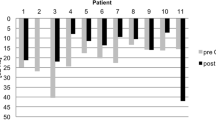Summary
In the last decade, the rehabilitation of postlingually deaf adults and prelingually deaf children with cochlear implants has been established as a treatment of deafness. The technological development of the implant devices and improvement of the surgical technique have led to a considerable increase of hearing performance during the last years. The postlingually deaf adults are able to use the telephone and may be integrated in their original job. Prelingually deaf children can even visit normal schools after cochlear implantation and hearing rehabilitation training. In order to preoperatively establish the state of the cochlea, radiological diagnosis of the temporal bone is necessary. High resolution computerized tomography imaging of the temporal bone with coronar and axial 1 mm slices and MRI with thin slice technique (three dimensional, T2 weighted turbo-spinecho sequence with 0.7 mm slices) have proved to be valuable according to our experience. Furthermore a postoperative synoptical X-ray, in a modified Chausse III projection, offers good information about the position of the implant and insertion of the stimulating electrode into the cochlea.
Zusammenfassung
In der letzten Dekade hat sich der operative Einsatz von Cochlearimplantaten für die Rehabilitation taubgeborener Kinder und ertaubter Erwachsenen als erfolgreiche Therapie etabliert. Durch technische Weiterentwicklung der Implantatsysteme und Verbesserung der Operationstechnik konnten in den letzten Jahren die Hörleistungen der Patienten deutlich verbessert werden. Postlingual ertaubte Erwachsene können nun oftmals wieder ins Berufsleben eingegliedert werden und prälingual ertaubte Kinder können reguläre Schulen besuchen. Im Rahmen der Voruntersuchung für die Cochlearimplantation ist die radiologische Felsenbeindiagnostik von besonderer Bedeutung. Hochauflösendes CT des Felsenbeins in koronaren und axialen Ebenen mit 1 mm Schichtdicke und MRT in Dünnschichttechnik (dreidimensionale, T2-gewichtete Turbospinechosequenz mit 0,7 mm Schichtdicke) haben sich nach unseren Erfahrungen bewährt. Das postoperative Übersichtsröntgen, modifiziert nach Chausse III, bietet gute Informationen über die Lage des Implantates und über die Insertion der Stimulationselekrode in die Schnecke.
Similar content being viewed by others
Author information
Authors and Affiliations
Rights and permissions
About this article
Cite this article
Gstoettner, W., Hamzavi, J. & Czerny, C. Rehabilitation of deaf persons with cochlear implants. Radiologe 37, 991–994 (1997). https://doi.org/10.1007/s001170050312
Issue Date:
DOI: https://doi.org/10.1007/s001170050312




